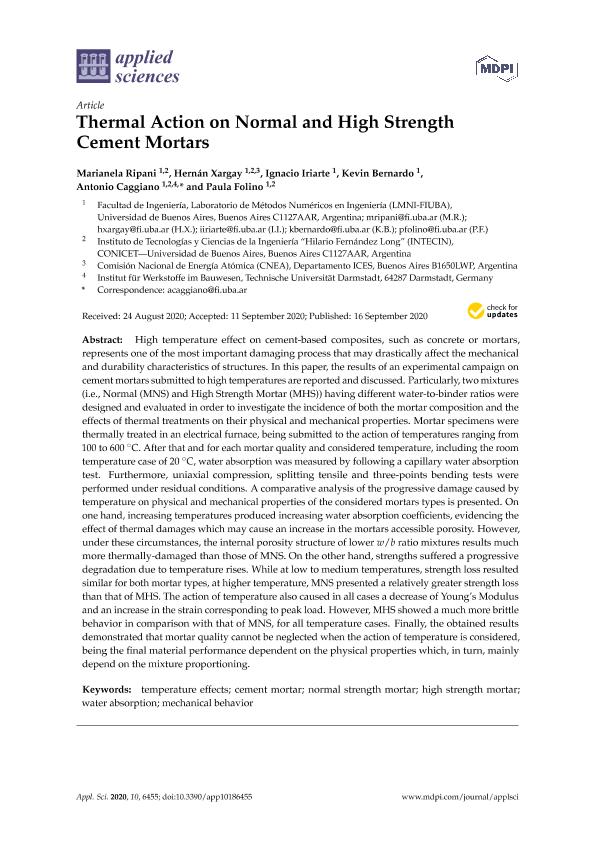Mostrar el registro sencillo del ítem
dc.contributor.author
Ripani, Marianela

dc.contributor.author
Xargay, Hernan Daniel

dc.contributor.author
Iriarte, Ignacio Tomás

dc.contributor.author
Bernardo Valeri, Kevin Eric

dc.contributor.author
Caggiano, Antonio

dc.contributor.author
Folino, Paula Cecilia
dc.date.available
2021-06-07T14:47:39Z
dc.date.issued
2020-09
dc.identifier.citation
Ripani, Marianela; Xargay, Hernan Daniel; Iriarte, Ignacio Tomás; Bernardo Valeri, Kevin Eric; Caggiano, Antonio; et al.; Thermal action on normal and high strength cement mortars; Molecular Diversity Preservation International; Applied Sciences; 10; 18; 9-2020; 1-19
dc.identifier.issn
2076-3417
dc.identifier.uri
http://hdl.handle.net/11336/133331
dc.description.abstract
High temperature effect on cement-based composites, such as concrete or mortars, represents one of the most important damaging process that may drastically affect the mechanical and durability characteristics of structures. In this paper, the results of an experimental campaign on cement mortars submitted to high temperatures are reported and discussed. Particularly, two mixtures (i.e., Normal (MNS) and High Strength Mortar (MHS)) having different water-to-binder ratios were designed and evaluated in order to investigate the incidence of both the mortar composition and the effects of thermal treatments on their physical and mechanical properties. Mortar specimens were thermally treated in an electrical furnace, being submitted to the action of temperatures ranging from 100 to 600 °C. After that and for each mortar quality and considered temperature, including the room temperature case of 20 °C, water absorption was measured by following a capillary water absorption test. Furthermore, uniaxial compression, splitting tensile and three-points bending tests were performed under residual conditions. A comparative analysis of the progressive damage caused by temperature on physical and mechanical properties of the considered mortars types is presented. On one hand, increasing temperatures produced increasing water absorption coefficients, evidencing the effect of thermal damages which may cause an increase in the mortars accessible porosity. However, under these circumstances, the internal porosity structure of lower w/b ratio mixtures results much more thermally-damaged than those of MNS. On the other hand, strengths suffered a progressive degradation due to temperature rises. While at low to medium temperatures, strength loss resulted similar for both mortar types, at higher temperature, MNS presented a relatively greater strength loss than that of MHS. The action of temperature also caused in all cases a decrease of Young's Modulus and an increase in the strain corresponding to peak load. However, MHS showed a much more brittle behavior in comparison with that of MNS, for all temperature cases. Finally, the obtained results demonstrated that mortar quality cannot be neglected when the action of temperature is considered, being the final material performance dependent on the physical properties which, in turn, mainly depend on the mixture proportioning.
dc.format
application/pdf
dc.language.iso
eng
dc.publisher
Molecular Diversity Preservation International

dc.rights
info:eu-repo/semantics/openAccess
dc.rights.uri
https://creativecommons.org/licenses/by-nc-sa/2.5/ar/
dc.subject
CEMENT MORTAR
dc.subject
HIGH STRENGTH MORTAR
dc.subject
MECHANICAL BEHAVIOR
dc.subject
NORMAL STRENGTH MORTAR
dc.subject
TEMPERATURE EFFECTS
dc.subject
WATER ABSORPTION
dc.subject.classification
Ingeniería Civil

dc.subject.classification
Ingeniería Civil

dc.subject.classification
INGENIERÍAS Y TECNOLOGÍAS

dc.title
Thermal action on normal and high strength cement mortars
dc.type
info:eu-repo/semantics/article
dc.type
info:ar-repo/semantics/artículo
dc.type
info:eu-repo/semantics/publishedVersion
dc.date.updated
2021-03-26T19:54:10Z
dc.journal.volume
10
dc.journal.number
18
dc.journal.pagination
1-19
dc.journal.pais
Suiza

dc.journal.ciudad
Basel
dc.description.fil
Fil: Ripani, Marianela. Consejo Nacional de Investigaciones Científicas y Técnicas. Oficina de Coordinación Administrativa Houssay. Instituto de Tecnologías y Ciencias de la Ingeniería "Hilario Fernández Long". Universidad de Buenos Aires. Facultad de Ingeniería. Instituto de Tecnologías y Ciencias de la Ingeniería "Hilario Fernández Long"; Argentina
dc.description.fil
Fil: Xargay, Hernan Daniel. Consejo Nacional de Investigaciones Científicas y Técnicas. Oficina de Coordinación Administrativa Houssay. Instituto de Tecnologías y Ciencias de la Ingeniería "Hilario Fernández Long". Universidad de Buenos Aires. Facultad de Ingeniería. Instituto de Tecnologías y Ciencias de la Ingeniería "Hilario Fernández Long"; Argentina. Comisión Nacional de Energía Atómica; Argentina
dc.description.fil
Fil: Iriarte, Ignacio Tomás. Universidad de Buenos Aires. Facultad de Ingeniería; Argentina
dc.description.fil
Fil: Bernardo Valeri, Kevin Eric. Universidad de Buenos Aires. Facultad de Ingeniería; Argentina
dc.description.fil
Fil: Caggiano, Antonio. Consejo Nacional de Investigaciones Científicas y Técnicas. Oficina de Coordinación Administrativa Houssay. Instituto de Tecnologías y Ciencias de la Ingeniería "Hilario Fernández Long". Universidad de Buenos Aires. Facultad de Ingeniería. Instituto de Tecnologías y Ciencias de la Ingeniería "Hilario Fernández Long"; Argentina
dc.description.fil
Fil: Folino, Paula Cecilia. Consejo Nacional de Investigaciones Científicas y Técnicas. Oficina de Coordinación Administrativa Houssay. Instituto de Tecnologías y Ciencias de la Ingeniería "Hilario Fernández Long". Universidad de Buenos Aires. Facultad de Ingeniería. Instituto de Tecnologías y Ciencias de la Ingeniería "Hilario Fernández Long"; Argentina
dc.journal.title
Applied Sciences
dc.relation.alternativeid
info:eu-repo/semantics/altIdentifier/url/https://www.mdpi.com/2076-3417/10/18/6455
dc.relation.alternativeid
info:eu-repo/semantics/altIdentifier/doi/http://dx.doi.org/10.3390/app10186455
Archivos asociados
